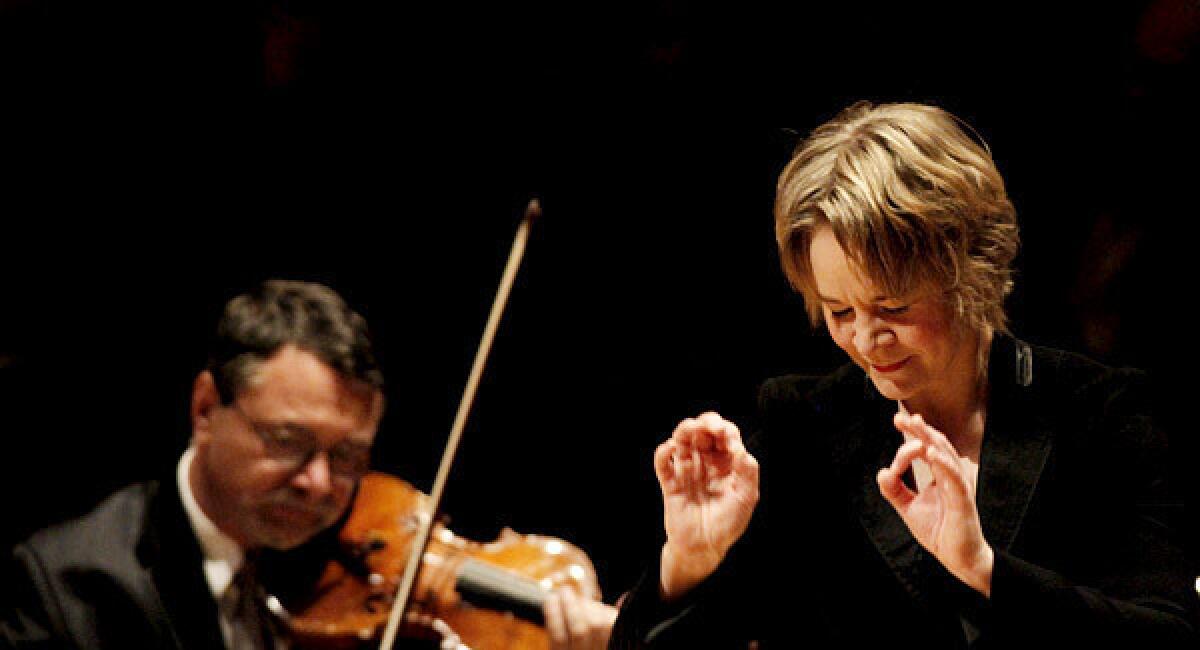Review: Susanna Malkki conducts a knockout program at L.A. Phil

- Share via
When Susanna Mälkki made her Los Angeles Philharmonic debut in 2010 it was hoped — at least by me — that the Finnish conductor would be invited back to show what she could really do. She was. And Sunday afternoon in Walt Disney Concert Hall, she did.
As music director of Ensemble Intercontemporain, the elite French new music group founded by Pierre Boulez, Mälkki has the inevitable reputation of being a new music specialist. Of the 10 CDs she’s made, nine are of European or Scandinavian Modernist composers.
But that’s not the whole story. The 10th is a disc in which Mälkki and the Gothenburg Symphony accompany mezzo-soprano Katarina Karnéus in Mahler songs. The performances are uncompromisingly and stunningly dark and deep.
PHOTOS: Arts and culture in pictures by The Times
At Disney three seasons ago Mälkki did her duty by premiering Mark-Anthony Turnage’s “Hammered Out,” which is little more than a superficial Beyoncé cover the L.A. Phil had commissioned. The rest of the program was a teenage Mozart Violin Concerto and Strauss’ “Also Sprach Zarathustra,” given a thoughtfully precise reading.
This time around, Mälkki brought her own choice in newer-sounding new music. The Violin Concerto was Stravinsky’s (Herbert Glass’ program note reminded us that Stravinsky dissed Mozart’s concerto when he wrote his own).
The standard repertory was Brahms’ Fourth Symphony. Brahms from a Boulezian didn’t seem promising. It was a knockout. But, then, everything this afternoon was.
Mälkki’s choice of a contemporary piece was the first U.S. performance of Enno Poppe’s “Markt” (“Market”), which Mälkki premiered in Cologne four years ago. The German composer, born in 1969, is relatively well known at home; much, much less so in the U.S. His mathematical and whimsically weird music is not on our orchestras’ radars. Maybe that’s now changed.
Poppe likes curious proportions. The ratio of the lengths of the three movements of “Markt” is 15:55:100, which means the first is like a prelude. He begins by having the string players each tap out something slightly different, sounding like insects at intriguingly purposeful work. The middle section meanders through a strange sonic landscape. It’s in the long last part when things start to get really interesting.
An exotic five-note flute theme circles upon itself and eventually blows through the large orchestra, gaining hurricane force by the time it reaches loose metal percussion. Poppe’s idea seems to have been to convey the chaos, colors and musical smells of a marketplace. The L.A. Phil did so in brilliant, wide-screen Technicolor. Surely this is what he wanted.
FULL COVERAGE: 2013 Spring arts preview
Leila Josefowicz was the hot violin soloist in Stravinsky’s concerto. Surely that’s not what Stravinsky wanted. His model was Bach and his temperature setting was cool. But he was also a man of rhythm. Who knows? He just might have, along with what seemed like everyone else in the hall Sunday, been persuaded.
The L.A. Phil came to this concerto late. Although written in 1931, a few years before the composer moved to L.A., the score wasn’t programmed by his local orchestra until 1965. In fact, Stravinsky recorded the concerto in Hollywood with Isaac Stern and the players of the L.A. Phil, but the orchestra was called, for contractual reasons, the Columbia Symphony. Under Esa-Pekka Salonen, the L.A. Phil went on to make two more recordings of the concerto with Cho-Liang Lin and Viktoria Mullova as soloists, meaning the orchestra has recorded the piece more than any other.
On this occasion, Mälkki played the straight woman with the musicians. Accents were sharp; details nicely articulated; balances carefully maintained; rhythms in place. It was a solid ground for Josefowicz, who clearly had no intention of leaving it that way.
In the first movement, a toccata, she kept her tone small, sometimes allowing herself to be buried by the band, only to seductively wriggle out. For the two arias, the central movements, she became a diva, grand and a little outrageous as she nudged extra helpings of expression out of the end of phrases and souped up her vibrato. In the Capriccio at the end she simply went to town, a welcome reminder that this was by the composer of “Rite of Spring.”
The Brahms’ Fourth was Stravinskian too, and startlingly so. Mälkki once more etched lines with a crisp and dry sensibility. She luxuriated in nothing. She brought out details that took the breath away. She demonstrated Brahms as the progressive that Schoenberg had claimed he was. Harmonies felt intended for the 20th century. A too-played symphony was given new life.
Mälkki completes her sixth and final season with the Ensemble Intercontemporain this year. She has no new post yet. What are the world’s major orchestras waiting for?
MORE
INTERACTIVE: Christopher Hawthorne’s On the Boulevards
CHEAT SHEET: Spring Arts Preview
PHOTOS: Arts and culture in pictures
More to Read
The biggest entertainment stories
Get our big stories about Hollywood, film, television, music, arts, culture and more right in your inbox as soon as they publish.
You may occasionally receive promotional content from the Los Angeles Times.











